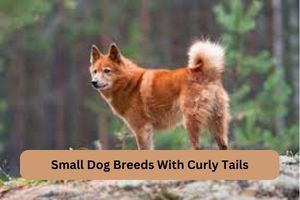Small Dog Breeds With Curly Tails
Tails are fascinating appendages, especially for those of us who don’t have them. They come in various shapes and sizes, from long and whip-like to short and stubby, and some even curl up and over the back. Dogs and cats primarily use their tails for communication, while certain water-loving dogs utilize them as rudders while swimming. Regardless of their purpose, there’s no denying that tails are incredibly adorable, especially when they’re curly. If you’re curious about dog breeds that sport curly tails, we’ve compiled a list of 20 breeds with this endearing feature. Take a look at the slideshow below and let us know if any of the included breeds surprised you!
Why do some dogs have curly tails?
There are a couple of explanations for why some dog breeds have curly tails. The anatomical reason behind curly tails is often attributed to “hemivertebrae.” This means that the bones in a dog’s tail, which is an extension of the spine, are wedge-shaped, resulting in a spiral shape. In these breeds, hemivertebrae are normal and expected, and they are responsible for their curly tails. However, it’s important to note that dogs can also have hemivertebrae as a medical condition in their spine, which can lead to health problems. This condition is similar to scoliosis in humans and can be diagnosed through X-rays.
From an evolutionary perspective, the reason for curly tails is not as clear. Some groups of dog breeds, like Scandinavian breeds, tend to have curly tails. For cold-weather breeds, a fluffy and curly tail can be quite useful. When these dogs are resting or sleeping, they can curl up in a cozy ball and cover their nose and face with their tail. It seems that a well-positioned fluffy tail, whether curly or not, could help keep a dog’s nose warm, but this is just a hypothesis.
However, there are other breeds that are not associated with cold weather, such as the Basenji from central Africa and the Chihuahua from Mexico, which also have curly tails. The reason for the curly tails in these breeds is less clear and may have different evolutionary explanations.
Different Types of Curled Dog Tails
The perception of curliness can vary from person to person. In the context of the article, all the dogs mentioned have some degree of curliness in their tails. However, it’s important to note that there are different variations of curly tails, including:
- Corkscrew: This refers to a tail that is tightly curled, forming a complete loop back onto itself. On short-haired breeds like Pugs, these tails are sometimes referred to as “pig tails.”
- Sickle: These tails have a curved shape but do not form a complete circle. Many dog breeds on the list exhibit varying levels of tail curliness within the breed.
- Snap tail: This term is often used to describe curly tails, particularly in cold-climate dogs whose tails curl up and back over the dog’s spine. When a dog’s tail is pulled back towards its head, it is referred to as a “snapped” tail.
It’s worth noting that these terms describe different degrees and types of curliness in dog tails.

Akita & American Akita
The Akita is a beautiful breed renowned for its curly and fluffy tail. This large breed originated in Japan during the 17th century and belongs to the Spitz family. In Japan, the Akita is highly respected and symbolizes qualities such as health, happiness, protection, and long life. Many dog enthusiasts are familiar with the heartwarming story of Hachiko, the beloved pup from the 1920s who faithfully waited at the train station for nine years after his owner’s passing.
Akitas are known for their substantial size, muscular build, double coats, and distinctive screw tails. They possess a strong personality and require a family that can establish and enforce rules. When fully grown, Akitas can weigh anywhere between 70 to 130 pounds and typically live for about 10 to 13 years. The curly and fluffy tail of the Akita helps keep their noses warm in cold wintry conditions.
Alaskan Malamute
The Alaskan Malamute is widely recognized for its striking physical resemblance to wolves. These dogs possess long, thick double coats adorned with markings reminiscent of their wild wolf ancestors. They are descendants of the wolves that roamed the northwestern regions of Alaska. The Malamute is a large breed, typically weighing between 70 to 90 pounds or even more. With proper care, they can live for about 10 to 14 years.
American Eskimo Dog
The American Eskimo dog is a breed recognized for its curly tail and distinguished by its white, fluffy coat. These dogs have beautifully curved and fluffy tails. They bear a resemblance to a smaller version of another breed called the Samoyed. The American Eskimo dog comes in three sizes: standard, miniature, and toy. It’s important to note that despite their name, these dogs did not originate from the indigenous Eskimo people. They actually have German origins and are descendants of the German Spitz breed. This breed is often affectionately referred to as Eskie or Eskies.
Basenji
The Basenji is an African breed renowned for its unique trait of being “barkless.” Classified as hounds, Basenjis are an ancient breed characterized by almond-shaped eyes, tall ears, short and smooth coats, long legs, and tightly curled tails. Their coats come in various colors such as black, red, brindle, or black and tan. It’s common for Basenjis to have white markings on their feet and legs, regardless of the coat color.
Medium in size, Basenjis typically weigh between 20 to 24 pounds. They are highly energetic, affectionate, and lively. This breed showcases high intelligence but can also exhibit a stubborn streak, making training them a challenge. Due to their quiet nature and self-grooming tendencies, Basenjis have been likened to cats. They may even climb, further emphasizing the feline comparison.
Bulldogs
Bulldogs are a type of dog that can have various tail types, including the curly corkscrew tail commonly seen in English Bulldogs. English Bulldogs can range in size from medium to large and typically weigh between 40 to over 60 pounds when fully grown. They have a lifespan of about 8 to 10 years. Bulldogs are known for their shorter, sleek coats that require minimal shedding. The coat colors of Bulldogs can vary and include shades of brown, white, brindle, cream, red, fawn, and even spotted patterns.
These dogs have small, flat faces and often exhibit an underbite, which gives them a pouty appearance. Despite their tough exterior and the negative reputation they sometimes receive, Bulldogs are known for their loyalty and friendliness. They make excellent family pets. However, Bulldogs can also display stubbornness and independence, which can make training them a bit challenging.
Tails are fascinating appendages, especially for those of us who don’t have them.


